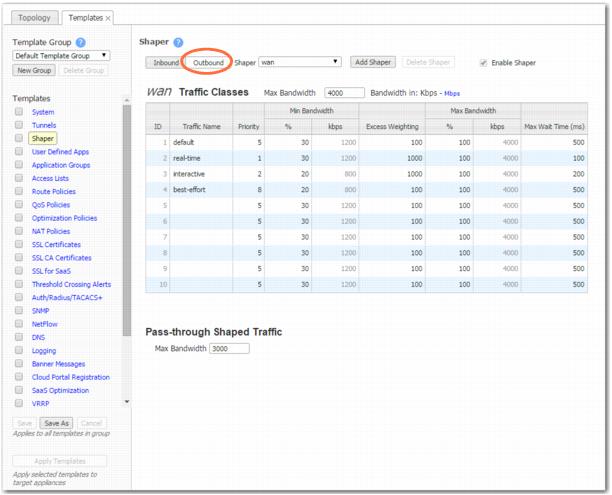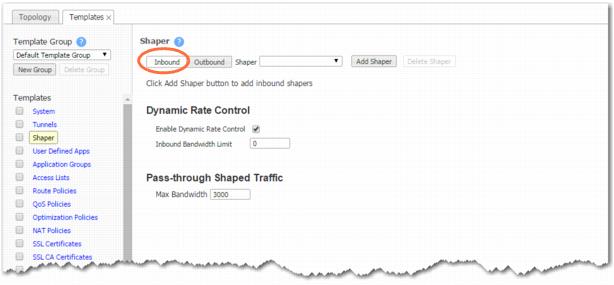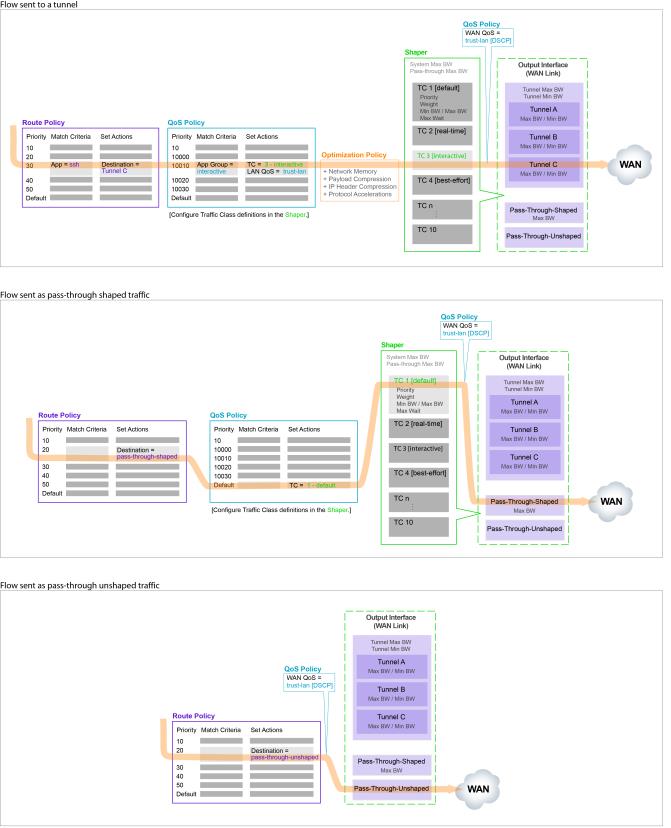The Shaper template is a simplified way of globally configuring QoS (Quality of Service) on the appliances:
|
n
|
The Shaper shapes traffic by allocating bandwidth as a percentage of the system bandwidth.
|
|
n
|
The Shaper's parameters are organized into ten traffic classes. Four traffic classes are preconfigured and named --- real-time, interactive, default, and best effort.
|
|
n
|
Applying the template to an appliance updates its system-level wan Shaper. If the appliance has any added, interface-specific Shapers, they are preserved.
|
|
n
|
To view any applied configurations, access the Configuration > Shaper page.
|
Tunnel Max Bandwidth is the maximum rate at which an appliance can transmit.
Auto BW negotiates the link between a pair of appliances. In this example, the appliances negotiate each link down to the lower value, 100 Mbps.
If Hub experiences congestion:
|
n
|
Enable Dynamic Rate Control. That allows Hub to regulate the tunnel traffic by lowering each remote appliance's Tunnel Max Bandwidth. The smallest possible value is that appliance's Tunnel Min(imum) Bandwidth.
|
|
n
|
Inbound BW Limit caps how much the appliance can receive.
|
|
n
|
By default, the values are the same for Max [WAN] Bandwidth (for tunnelized traffic) and the Max Bandwidth for pass-through shaped traffic.
|
|
n
|
However, you can cap the maximum amount of bandwidth allocated to pass-through shaped traffic by entering an upper limit in the Pass-through Shaped Traffic Max Bandwidth field.
|
It’s important to note that this is not the same as configuring a percentage of Max WAN BW. This calculation is done after exiting the Shaper, so until that point, all shaped packets have queued through the traffic classes as they arrived. As a result, pass-through packets in a higher priority traffic class have a better chance of getting through in the event that the max is exceeded, or if congestion occurs.
|
n
|
Priority: Determines the order in which to allocate each class's minimum bandwidth - 1 is first, 10 is last.
|
|
n
|
Min Bandwidth: Refers to the percentage of bandwidth guaranteed to each traffic class, allocated by priority. However, if the sum of the percentages is greater than 100%, then lower-priority traffic classes might not receive their guaranteed bandwidth if it's all consumed by higher-priority traffic.
|
|
n
|
Excess Weighting: If there is bandwidth left over after satisfying the minimum bandwidth percentages, then the excess is distributed among the traffic classes, in proportion to the weightings specified in the Excess Weighting column. Values range from 1 to 10,000.
|
|
n
|
Max Bandwidth: You can limit the maximum bandwidth that a traffic class uses by specifying a percentage in the Max Bandwidth column. The bandwidth usage for the traffic class will never exceed this value.
|
|
n
|
Max Wait Time: Any packets waiting longer than the specified Max Wait Time are dropped.
|
The following diagram illustrates a flow's progress through the policies and the Shaper when the Route Policy Set Action, Destination, is:
Note  If the Route Policy's Set Action is auto-optimized and the local appliance initiates either TCP-based or IP-based handshaking, then the remote appliance determines which tunnel to use, based on information it receives in the first packets from the local appliance. (For more information about auto-optimization, see the Appliance Manager Operator's Guide.)
If the Route Policy's Set Action is auto-optimized and the local appliance initiates either TCP-based or IP-based handshaking, then the remote appliance determines which tunnel to use, based on information it receives in the first packets from the local appliance. (For more information about auto-optimization, see the Appliance Manager Operator's Guide.)




